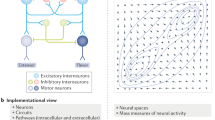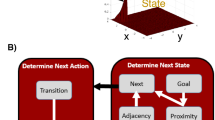Abstract
Brain-imaging techniques have made it possible to explore the neural foundations of logical and mathematical cognition. These techniques are revealing more than simply where these high-order processes take place in the human cortex. Imaging is beginning to answer some of the oldest questions about what logic and mathematics are, and how they emerge and evolve through visuospatial cognition, language, executive functions and emotion.
This is a preview of subscription content, access via your institution
Access options
Subscribe to this journal
Receive 12 print issues and online access
$189.00 per year
only $15.75 per issue
Buy this article
- Purchase on Springer Link
- Instant access to full article PDF
Prices may be subject to local taxes which are calculated during checkout




Similar content being viewed by others
References
Fischer, K. & Kaplan, U. in The Encyclopedia of Cognitive Science Vol. 3 (ed. Nadel, L.) 679–682 (Nature Publishing Group, Macmillan, London, 2003).
Changeux, J.-P. & Connes, A. Conversations on Mind, Matter, and Mathematics (Princeton Univ. Press, Princeton, 1998).
Gardner, H. Frames of Mind: The Theory of Multiple Intelligences (Basic Books, New York, 1993).
Fodor, J. The Modularity of Mind (The MIT Press, Cambridge, 1983).
Fodor, J. The Mind Doesn't Work That Way (The MIT Press, Cambridge, 2000).
Kosslyn, S. M. & Rosenberg, R. Psychology: the Brain, the Person, the World (Allyn and Bacon, Boston, 2001).
Braine, M. D. S. & O'Brien, D. P. (eds) Mental Logic (Erlbaum, Hove, 1998).
Johnson-Laird, P. N. Mental models and deduction. Trends Cogn. Sci. 5, 434–442 (2001).
Mellet, E., Petit, L., Denis, M. & Tzourio-Mazoyer, N. Reopening the mental imagery debate: lessons from functional anatomy. NeuroImage 8, 129–139 (1998).
Goel, V., Gold, B., Kapur, S. & Houle, S. The seats of reason? An imaging study of deductive and inductive reasoning. NeuroReport 8, 1305–1310 (1997).
Goel, V., Gold, B., Kapur, S. & Houle, S. Neuroanatomical correlates of human reasoning. J. Cogn. Neurosci. 10, 293–302 (1998).
Goel V., Buchel, C., Frith, C. & Dolan, R. Dissociation of mechanisms underlying syllogistic reasoning. NeuroImage 12, 504–514 (2000).
Wharton, C. M. & Grafman, J. Deductive reasoning and the brain. Trends Cogn. Sci. 2, 54–59 (1998).
Langer, J. The descent of cognitive development. Dev. Sci. 3, 361–388 (2000).
Baillargeon, R. & Wang, S. Event categorization in infancy. Trends Cogn. Sci. 6, 85–92 (2002).
Evans, J. St. B. T. Bias in Human Reasoning: Causes and Consequences (Erlbaum, London, 1989).
Gaukroger, S. in The Encyclopedia of Cognitive Science Vol. 1 (ed. Nadel, L.) 947–950 (Nature Publishing Group, Macmillan, London, 2003).
Houdé, O. et al. Shifting from the perceptual brain to the logical brain: the neural impact of cognitive inhibition training. J. Cogn. Neurosci. 12, 721–728 (2000).
Evans, J. St B. T. Matching bias in conditional reasoning. Thinking Reasoning 4, 45–82 (1998).
Raichle, M. E. et al. Practice-related changes in human brain functional anatomy during non-motor learning. Cereb. Cortex 4, 8–26 (1994).
Sakai, K. et al. Transition of brain activation from frontal to parietal areas in visuomotor sequence learning. J. Neurosci. 18, 1827–1840 (1998).
Diamond, A., Kirkham, N. & Amso, D. Conditions under which young children can hold two rules in mind and inhibit a prepotent response. Dev. Psychol. 38, 352–362 (2002).
Houdé, O. Inhibition and cognitive development: object, number, categorization, and reasoning. Cogn. Dev. 15, 63–73 (2000).
Dehaene S., Kerszberg M. & Changeux, J.-P. A neuronal model of a global workspace in effortful cognitive tasks. Proc. Natl Acad. Sci. USA 95, 14529–14534 (1998).
Smith, E. E. & Jonides, J. Storage and executive processes in the frontal lobes. Science 283, 1657–1661 (1999).
Miller, E. K. The prefrontal cortex and cognitive control. Nature Rev. Neurosci. 1, 59–65 (2000).
Fuster, J. M. Linkage at the top. Neuron 21, 1223–1229 (1998).
Goel, V. & Dolan, R. J. Explaining modulation of reasoning by belief. Cognition 87, 11–22 (2003).
Moutier, S. Deductive reasoning and matching-bias inhibition training in school children. Curr. Psychol. Cogn. 19, 429–452 (2000).
Fuster, J. The Prefrontal Cortex: Anatomy, Physiology, and Neuropsychology of the Frontal Lobe (Lippincott, New York, 1997).
Bjorklund, D. F. In search of a metatheory for cognitive development (or, Piaget is dead and I don't feel so good). Child Dev. 68, 144–148 (1997).
Johnson, M. H. Functional brain development in humans. Nature Rev. Neurosci. 2, 475–483 (2001).
Durston, S. et al. A neural basis for the development of inhibitory control. Dev. Sci. 5, 9–16 (2002).
Casey, B. J., Davidson, M. & Rosen, B. Functional magnetic resonance imaging: basic principles of and application to developmental science. Dev. Sci. 5, 301–309 (2002).
Thompson-Schill, S. L., D'Esposito, M., Aguirre, G. K. & Farah, M. J. Role of left inferior prefrontal cortex in retrieval of semantic knowledge: a reevaluation. Proc. Natl Acad. Sci. USA 94, 14792–14797 (1997).
Thompson-Schill, S. L., D'Esposito, M. & Kan, I. P. Effects of repetition and competition on activity in left prefrontal cortex during word generation. Neuron 23, 513–522 (1999).
Konishi, S. et al. Transient activation of inferior prefrontal cortex during cognitive set shifting. Nature Neurosci. 1, 80–84 (1998).
Konishi, S. et al. Common inhibitory mechanism in human inferior prefrontal cortex revealed by event-related functional MRI. Brain 122, 981–991 (1999).
Nakahara, K., Hayashi, T., Konishi, S. & Miyashita, Y. Functional MRI of macaque monkeys performing a cognitive set-shifting task. Science 295, 1532–1536 (2002).
Jonides, J., Smith, E. E., Marshuetz, C. & Koeppe, R. A. Inhibition in verbal working memory revealed by brain activation. Proc. Natl Acad. Sci. USA 95, 8410–8413 (1998).
D'Esposito, M., Postle, B. R. & Rypma, B. Prefrontal cortical contributions to working memory: evidence from event-related fMRI studies. Exp. Brain Res. 133, 2–11 (2000).
Logothetis, N. K., Pauls, J., Augath, M. A., Trinath, T. & Oeltermann, A. Neurophysiological investigation of the basis of the fMRI signal. Nature 412, 150–157 (2001).
Caesar, K., Gold, L. & Lauritzen, M. Context sensitivity of activity-dependent increases in cerebral blood flow. Proc. Natl Acad. Sci. USA 100, 4239–4244 (2003).
Tupper, D. E. in The Encyclopedia of Cognitive Science Vol. 2 (ed. Nadel, L.) 965–969 (Nature Publishing Group, Macmillan, London, 2003).
McIntosh, A. R., Rajah, M. N. & Lobaugh, N. J. Interactions of prefrontal cortex in relation to awareness in sensory learning. Science 284, 1531–1533 (1999).
Damasio, A. R. Descartes' Error: Emotion, Reason, and the Human Brain (Grosset, Putnam, New York, 1994).
Damasio, A. R. The Feeling of What Happens: Body and Emotion in the Making of Consciousness (Harcourt Brace, New York, 1999).
Damasio, H, Grabowski, T., Frank, R., Galaburda, A. & Damasio, A. R. The return of Phineas Gage: clues about the brain from the skull of a famous patient. Science 264, 1102–1105 (1994).
Houdé, O. et al. Access to deductive logic depends on a right ventromedial prefrontal area devoted to emotion and feeling: evidence from a training paradigm. NeuroImage 14, 1486–1492 (2001).
Tranel, D., Bechara, A. & Denburg, N. L. Asymmetric functional roles of right and left ventromedial prefrontal cortices in social conduct, decision-making, and emotional processing. Cortex 38, 589–612 (2002).
Houdé, O. Consciousness and unconsciousness of logical reasoning errors in the human brain. Behav. Brain Sci. (in the press).
Bush, G., Luu, P. & Posner, M. I. Cognitive and emotional influences in anterior cingulate cortex. Trends Cogn. Sci. 4, 215–222 (2000).
Gehring, W. & Willoughby, A. The medial frontal cortex and the rapid processing of monetary gains and losses. Science 295, 2279–2282 (2002).
Carey, S. in Developmental Cognitive Neuroscience (eds Nelson, C. A. & Luciana, M.) 415–431 (The MIT Press, Cambridge, 2001).
Wynn, K. Addition and subtraction by human infants. Nature 358, 749–750 (1992).
Wynn, K. Findings of addition and subtraction in infants are robust and consistent. Child Dev. 71, 1535–1536 (2000).
Hauser, M. D., MacNeilage, P. & Ware, M. Numerical representations in primates. Proc. Natl Acad. Sci. USA 93, 1514–1517 (1996).
Hauser, M. D. Wild Minds: What Animals Really Think (Henry Holt, New York, 2000).
Simon, T. J. Reconceptualizing the origins of number knowledge: a 'non-numerical' account. Cogn. Dev. 12, 349–372 (1997).
Simon, T. J. The foundations of numerical thinking in a brain without numbers. Trends Cogn. Sci. 3, 363–365 (1998).
Houdé, O. Numerical development: from the infant to the child. Wynn's (1992) paradigm in 2- and 3-year-olds. Cogn. Dev. 12, 373–392 (1997).
Spelke, E. S. & Tsivkin, S. Language and number: a bilingual training study. Cognition 78, 45–88 (2001).
Dehaene, S., Spelke, E., Pinel, P., Stanescu, R. & Tsivkin, S. Sources of mathematical thinking: behavioral and brain-imaging evidence. Science 284, 970–974 (1999).
Zago, L. et al. Neural correlates of simple and complex mental calculation. NeuroImage 13, 314–327 (2001).
Siegler, R. S. Emerging Minds: The Process of Change in Children's Thinking (Oxford Univ. Press, New York, 1996).
Dehaene, S., Dehaene, G. & Cohen, L. Abstract representations of numbers in the animal and human brain. Trends Neurosci. 21, 355–361 (1998).
Dehaene, S. Single-neuron arithmetic. Science 297, 1652–1653 (2002).
Nieder, A., Freedman, D. J. & Miller, E. K. Representation of the quantity of visual items in the primate prefrontal cortex. Science 297, 1708–1711 (2002).
Sawamura, H., Shima, K. & Tanji, J. Numerical representation for action in the parietal cortex of the monkey. Nature 415, 918–922 (2002).
Pesenti, M. et al. Mental calculation in a prodigy is sustained by right prefrontal and medial temporal areas. Nature Neurosci. 4, 103–108 (2001).
Butterworth, B. What makes a prodigy? Nature Neurosci. 4, 11–12 (2001).
Hauser, M. D., Chomsky, N. & Fitch, W. T. The faculty of language: what is it, who has it, and how did it evolve? Science 298, 1569–1579 (2002).
Zago, L. & Tzourio-Mazoyer, N. Distinguishing visuospatial working memory and complex mental calculation areas within the parietal lobes. Neurosci. Lett. 331, 45–49 (2002).
Simon, O., Mangin, J.-F., Cohen, L., Le Bihan, D. & Dehaene, S. Topographical layout of hand, eye, calculation, and language-related areas in the human parietal lobe. Neuron 33, 475–487 (2002).
Lakoff, G. & Nunez, R. Where Mathematics Comes From: How the Embodied Mind Brings Mathematics into Being (Basic Books, New York, 2000).
Acknowledgements
We would like to thank S. Moutier, L. Zago and B. Mazoyer for their contribution to our work on logical and mathematical cognition. Support for our work is provided by The Centre National de la Recherche Scientifique, the Commissariat à l'Energie Atomique, Université de Caen, Université Paris-5 (René-Descartes) and the Institut Universitaire de France. We are also grateful to V. Waltz for her help in preparing the manuscript.
Author information
Authors and Affiliations
Corresponding author
Rights and permissions
About this article
Cite this article
Houdé, O., Tzourio-Mazoyer, N. Neural foundations of logical and mathematical cognition. Nat Rev Neurosci 4, 507–514 (2003). https://doi.org/10.1038/nrn1117
Issue Date:
DOI: https://doi.org/10.1038/nrn1117
This article is cited by
-
The influence of semantic alignment on the performance of addition and division operation: age-related differences
Cognitive Processing (2023)
-
An Eye-Tracking Study of Structural Priming from Abstract Arithmetic to Chinese Structure NP1 + You + NP2 + Hen + AP
Journal of Psycholinguistic Research (2023)
-
Exploring problem conceptualization and performance in STEM problem solving contexts
Instructional Science (2020)
-
Neural correlates of free recall of “famous events” in a “hypermnestic” individual as compared to an age- and education-matched reference group
BMC Neuroscience (2018)
-
Neural circuitry governing anxious individuals’ mis-allocation of working memory to threat
Scientific Reports (2017)



